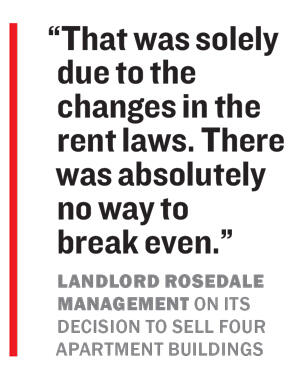After New York lawmakers passed the Housing Stability and Tenant Protection Act in 2019, greatly strengthening rent regulation in the state, investors were certain: Rent-stabilized buildings were no longer assets, but liabilities.
All manner of violent metaphors surfaced to explain just how bad the changes were for landlords.
The new law was “a horror show” that “gutted and neutered” routes to deregulation, insiders said at the time. Repairs would backlog, facades crumble. Hordes of mom-and-pop landlords would be forced to sell. On quarterly earnings calls, institutional players warned of a chilling effect on investment.
Over two years later, the market aftershocks are still unfolding, but two consequences have crystallized: Some struggling landlords were forced to sell, but where they’ve cut their losses, others see long-term opportunity.
Emerging from the rubble is a new crop of buyers — investors with deep pockets and deeper patience, willing to wait out a bet that the new rent law won’t hold forever.
Depreciating assets
From a data perspective, it’s hard to parse out precisely the extent to which HSTPA ruptured the real estate market, as another trauma, Covid, arrived directly on its heels.
While the rent law slowed landlords’ revenue streams, pandemic-related eviction bans brought some to a halt, essentially permitting nonpayment without consequence.
To account for the variable, NYU’s Furman Center dialed in on stabilized building statistics in the first quarter of 2020 to gauge the law’s short-term impacts with the potential to become permanent shifts.
Researchers found that less than a year after the bill’s passage, before the pandemic locked down New York City, stabilized buildings were already declining in value and owners were increasingly offloading these depreciating assets.
While the sale prices per square foot of all residential buildings dropped in the immediate wake of the rent law, the value of properties in which half of the units were stabilized fell disproportionately, the Furman Center found, and did not experience the rebound in pricing seen by less-stabilized residential buildings in early 2020.
“In this short-term period, we find that HSTPA had a statistically significant differential impact on the change in sales prices,” the report’s authors wrote. Sales volume, meanwhile, increased.
Rosedale Management, a third-generation owner and operator, has sold 10 of its 13 buildings since the start of last year. Covid-decimated rent rolls accelerated the firm’s retreat, but four of the buildings were listed immediately after the rent law passed in 2019, when new limits on rent hikes left the landlord with insufficient revenue to fund needed repairs. One building in Soundview sold for $700,000 less than what Rosedale had paid for it nearly a decade earlier.
“That was solely due to the changes in the rent laws,” a Rosedale spokesperson told The Real Deal in July. “There was absolutely no way to break even.”
 Running toward the fire
Running toward the fire
Digging into the rent law’s sweeping provisions, it’s easy to see why owners are tempted to sell. Avenues to deregulate have been severed, rent hikes for improvements squashed and raising rents was almost entirely left to the Rent Guidelines Board, which has voted to freeze them three times in the last seven years, and approved only modest increases in the other years.
“If you really look at rent-stabilized, the units are worth almost zero,” said Danny Fishman, CEO of multifamily investment firm Gaia Real Estate. “Why would you have an apartment where your taxes and maintenance are higher than your rent roll?”
“The only logical reason to invest would be if you think that sometime in the future the law will reverse,” he added.
While investors who are raising outside capital or looking to get in and out within five years are running away from rent-stabilized buildings, Marcus & Millichap broker Joe Koicim has observed a subset of investors who believe the rent law won’t be around forever.
The buyers in question are mostly well-heeled families who own property in the Bronx, Queens or Brooklyn, Koicim said, and are eyeing fully or partially regulated buildings in Manhattan as a long play — a wager that lawmakers will eventually chip away at HSTPA.
They see the lower prices, low yields and low interest rates of today as an opportunity to buy on the dip. And they’re operating on a decades-long timeline.
“They’re buying for generations, for their grandkids,” Koicim said.
Faith in SCOTUS
The notion that rent regulations could backslide is generally based on speculation that time begets change.
“Everybody expects at some point the political pendulum will swing the other way, because it always does,” said Michelle Maratto Itkowitz, a landlord and tenant attorney and founder of Itkowitz PLLC.
Landlord groups have lobbed at least five suits at HSTPA since its passage, arguing that the law violates the Fifth Amendment’s takings clause — that the government cannot seize property without compensation — and procedural due process under the Fourteenth Amendment.
All five have been dismissed, though the plaintiffs in most cases appealed. Oral arguments in the most prominent suit are expected to be heard in the Second Circuit before the end of the year. From the outset, the strategy has been to navigate the appeals process in the hope of getting the issue before the Supreme Court. The majority-conservative bench, landlords believe, might sympathize with real estate.
“The Supreme Court in recent years in a series of decisions has become more protective of property rights,” Andrew Pincus, the attorney representing the Rent Stabilization Association and Community Housing Improvement Program landlord groups in one of the cases, told TRD.
 One such decision came down in Cedar Point Nursery v. Hassid. In the June ruling, the Supreme Court held that a California law allowing union organizers regular access to farms to recruit workers without the consent of property owners resulted in an unconstitutional taking of property in violation of the Fifth Amendment.
One such decision came down in Cedar Point Nursery v. Hassid. In the June ruling, the Supreme Court held that a California law allowing union organizers regular access to farms to recruit workers without the consent of property owners resulted in an unconstitutional taking of property in violation of the Fifth Amendment.
“We think the New York rent stabilization law does exactly the same thing,” Pincus said, arguing that the law enables a stabilized unit to remain regulated in perpetuity and the lease to be passed down through succession rights, essentially denying the owner the right to the property.
Reaching the Supreme Court, however, could be a long shot. The court only agrees to hear about 100 to 150 of the over 7,000 cases put before it each year — about 1.5 to 2 percent.
Any revision to the law by the state legislature is equally unlikely next session. Democrats control the governorship and hold supermajorities in both houses of the legislature. To flip the state Senate, Republicans would need to gain 12 seats in the 2022 election.
Straight shooters
Owners do have an opportunity to make some money in the near term, though.
Itkowitz, whose firm provides rent-stabilization and regulatory due diligence for multifamily properties, said she has recently seen an influx of younger buyers looking to pick up stabilized buildings at a discount.
As part of her service, Itkowitz collects information on a building or unit’s ongoing litigation and violations. More often than not, a stabilized property will be steeped in both. An owner may have put off repairs in the wake of the rent-hike caps for improvements, for example, prompting the tenants to sue and channel their rent payments into an escrow account. The owner is left further behind on rent, still unable to afford repairs and with legal fees to boot — a vicious, expensive cycle.
To break it, Itkowitz advises incoming owners to first clean up the building.
“We’re not doing another goddamn thing until you fix every violation in this building,” she said.
In a case she recently took on — an eight-unit building in Brooklyn — the new owners followed her advice and fixed up the property. Rent started rolling in and all but a few cases were dropped, she said.
The remaining litigation concerned the rent-stabilized status of the building’s six occupied units. The tenants argued they should be paying a stabilized rent; their landlord had been charging them market rate.
After researching the apartments’ improvement history and comparing physical leases with the records kept by the state’s Division of Homes and Community Renewal, Itkowitz was sure that three of the units were stabilized; she couldn’t win those. On the other three, she felt she had a good chance of showing they should fetch market rate.
“The difference between these apartments being stabilized or not being stabilized is so huge to the future of the asset,” Itkowitz said. “That’s a fight worth having.”
Still, owners who get in at a reasonable price can have a viable business, she said, provided they run their buildings efficiently and are aboveboard about which units are deregulated and which are not.
“You can still make money organically,” she noted.
And because buyers in the market have generally been younger — late 30s to early 40s — there’s always the chance that they could cash in if the tenant-friendly rent law eventually shifts back in real estate’s favor.
A closing window
For the time being, there’s still one route to deregulation: apartment combinations.
Landlords who buy a stabilized property with a high number of vacancies are permitted to combine the unoccupied apartments and set a market-rate “first rent” for the next tenant, although rent increases after that are still subject to the new law.
Vacancies surged in the city during the pandemic, but they are now moving back toward pre-Covid levels. In August, Manhattan rentals had a 3.2 percent vacancy rate, down from July’s 6.1 percent. The survey, however, does not account for warehousing — vacant units kept unlisted in an attempt to spur demand or because rent hikes no longer cover needed renovations.
At the beginning of summer, Jonathan Miller, CEO of appraisal firm Miller Samuel, estimated that about one-third of the city’s inventory was hidden in this manner. In rent-stabilized buildings, Gaia’s Fishman said, it became common during the pandemic for owners to shutter an apartment in need of heavy repairs rather than drop the capital and risk not being able to find another renter.
The window to hike rents on stabilized units could be closing, though. A bill introduced by state Sen. Brian Kavanagh in June would block that profit opportunity by capping the rent of a combined apartment at the sum of the formerly separate units’ rents.
Itkowitz said she had heard the bill could pass as early as January, when state legislators go back into session.
“They’re gonna plug that hole, too,” she said.
